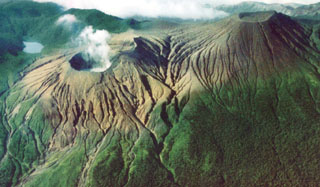Report on Rincon de la Vieja (Costa Rica) — November 2001
Bulletin of the Global Volcanism Network, vol. 26, no. 11 (November 2001)
Managing Editor: Richard Wunderman.
Rincon de la Vieja (Costa Rica) Fumarolically active through August 2001
Please cite this report as:
Global Volcanism Program, 2001. Report on Rincon de la Vieja (Costa Rica) (Wunderman, R., ed.). Bulletin of the Global Volcanism Network, 26:11. Smithsonian Institution. https://doi.org/10.5479/si.GVP.BGVN200111-345020
Rincon de la Vieja
Costa Rica
10.83°N, 85.324°W; summit elev. 1916 m
All times are local (unless otherwise noted)
During March 2000 through at least August 2001, fumarolic and seismic activity continued at Rincón de la Vieja. Fumarolic gases often irritated the eyes, skin, and throat.
On 1 March 2000 the crater lake was blue, with sulfur particles in suspension, a constant surge, and a temperature of 37°C. Compared to a visit in September 1999, the level of the lake was higher and the bubbling in the SW part had ended. The fumaroles on the NE (91°C) and SW walls were no longer steaming. The fumaroles on the NE flank (89°C) were steaming slightly. The edge of the crater displayed concentric 50-m-long and 40-cm-wide cracks.
During October 2000, the lake was gray with a high water level, sulfur particles floating on the surface, evaporation, and a temperature of 44°C. Fumarolic activity was observed in the SW and N wall of the main crater. The fumarolic area of the N flank (60°C) was steaming slightly, and sublimate deposition occurred.
During July 2001, OVSICORI-UNA reported that the level of the lake had descended ~2 m since mid-March. The lake was gray in color with sulfur particles floating on the surface; vigorous evaporation made observation of its bottom difficult, and its temperature stood at 58°C. In the SW wall there were small areas sliding towards the lake, and a new noisy fumarole appeared on the S wall. The fumaroles on the NE and SW walls remained active, producing gas columns that reached up to 300 m. The columns, often visible from the N and NW flanks, were blown by predominant winds towards the W and SW flanks. Low-frequency events and microearthquakes increased during June and August 2001. A summary of earthquakes at Rincón de la Vieja appears in table 4.
Table 4. Summary of earthquakes at Rincón de la Vieja during May 2000 to August 2001, registered by a seismograph at a station located 5 km SW of the main crater. The reported earthquakes include microseisms with amplitudes under 5 mm. The reported tremor durations were sums of discontinuous segments and were of low frequency (below 2 Hz). Missing months indicate that no data were available at the time of report preparation. Courtesy of OVSICORI-UNA.
| Month | LF | HF | Micro-earthquakes | Tremor duration | VT | Total |
| May 2000 | 3 | 1 | 25 | 105 minutes | -- | 29 |
| Aug 2000 | 8 | -- | 21 | 30 minutes | -- | 29 |
| Sep 2000 | 7 | -- | -- | 210 minutes | 11 | 18 |
| Mar 2001 | 2 | -- | 5 | -- | -- | 7 |
| May 2001 | 5 | -- | 2 | -- | -- | 7 |
| Jun 2001 | 12 | -- | 20 | -- | 1 | 33 |
| Aug 2001 | 35 | -- | 50 | -- | -- | 85 |
General References. Barquero, J., and others, 1978-1986, Estado de los Volcanes de Costa Rica (15 annual or semi-annual reports): Boletín de Vulcanología, nos. 2-13 and 15-17.
Garcia, M.O., and Malavassi, E. (eds.), 1983, Memoir, USA-Costa Rica Joint Seminar in Volcanology, San José, January 1982: Universidad Nacional, Heredia, 155 p. (18 papers).
Geological Summary. Rincón de la Vieja, the largest volcano in NW Costa Rica, is a remote volcanic complex in the Guanacaste Range. The volcano consists of an elongated, arcuate NW-SE-trending ridge constructed within the 15-km-wide early Pleistocene Guachipelín caldera, whose rim is exposed on the south side. Sometimes known as the "Colossus of Guanacaste," it has an estimated volume of 130 km3 and contains at least nine major eruptive centers. Activity has migrated to the SE, where the youngest-looking craters are located. The twin cone of Santa María volcano, the highest peak of the complex, is located at the eastern end of a smaller, 5-km-wide caldera and has a 500-m-wide crater. A Plinian eruption producing the 0.25 km3 Río Blanca tephra about 3,500 years ago was the last major magmatic eruption. All subsequent eruptions, including numerous historical eruptions possibly dating back to the 16th century, have been from the prominent active crater containing a 500-m-wide acid lake located ENE of Von Seebach crater.
Information Contacts: Observatorio Vulcanológico y Sismológico de Costa Rica, Universidad Nacional (OVSICORI-UNA), Apartado 86-3000, Heredia, Costa Rica.

